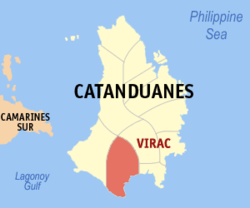Virac | |
|---|---|
 Virac Town Center | |
 Map of Catanduanes with Virac highlighted | |
Location within the Philippines | |
| Coordinates: 13°35′N 124°14′E / 13.58°N 124.23°E | |
| Country | Philippines |
| Region | Bicol Region |
| Province | Catanduanes |
| District | Lone district |
| Founded | 1775 |
| Barangays | 63 (see Barangays) |
| Government | |
| • Type | Sangguniang Bayan |
| • Mayor | Samuel V. Laynes |
| • Vice Mayor | Arlynn H. Arcilla |
| • Representative | Eulogio R Rodriguez |
| • Municipal Council | Members |
| • Electorate | 51,081 voters (2022) |
| Area | |
| • Total | 152.40 km2 (58.84 sq mi) |
| Elevation | 96 m (315 ft) |
| Population (2020 census)[3] | |
| • Total | 76,520 |
| • Density | 500/km2 (1,300/sq mi) |
| • Households | 16,951 |
| Economy | |
| • Income class | 1st municipal income class |
| • Poverty incidence | 15.07 |
| • Revenue | ₱ 270.7 million (2020), 118.2 million (2012), 131.1 million (2013) |
| • Assets | ₱ 983.9 million (2020), 263.4 million (2012), 318.7 million (2013) |
| • Expenditure | ₱ 241.5 million (2020) |
| • Liabilities | ₱ 222.3 million (2020), 53.56 million (2012), 80.67 million (2013) |
| Service provider | |
| • Electricity | First Catanduanes Electric Cooperative (FICELCO) |
| Time zone | UTC+8 (PST) |
| ZIP code | 4800 |
| PSGC | |
| IDD : area code | +63 (0)52 |
| Native languages | Bicol |
| Website | www |
Virac, officially the Municipality of Virac, is a 1st class municipality and capital of the province of Catanduanes, Philippines. According to the 2020 census, it has a population of 76,520 people.[3]
It is most populous and fifth largest in land area in Catanduanes.[5]
- ^ Municipality of Virac | (DILG)
- ^ "2015 Census of Population, Report No. 3 – Population, Land Area, and Population Density" (PDF). Philippine Statistics Authority. Quezon City, Philippines. August 2016. ISSN 0117-1453. Archived (PDF) from the original on May 25, 2021. Retrieved July 16, 2021.
- ^ a b Census of Population (2020). "Region V (Bicol Region)". Total Population by Province, City, Municipality and Barangay. Philippine Statistics Authority. Retrieved July 8, 2021.
- ^ "PSA Releases the 2021 City and Municipal Level Poverty Estimates". Philippine Statistics Authority. April 2, 2024. Retrieved April 28, 2024.
- ^ "Virac". Philippine Department of Tourism. Retrieved on June 28, 2010.



